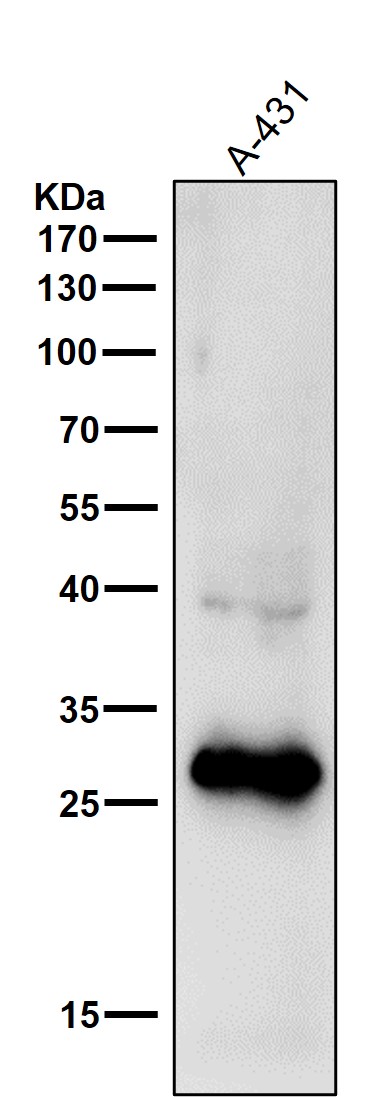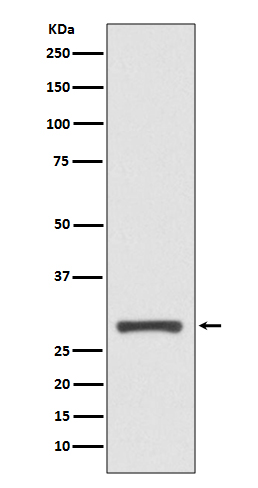


| WB | 1/1000-1/2000 | Human,Mouse,Rat |
| IF | 咨询技术 | Human,Mouse,Rat |
| IHC | 1/100-1/200 | Human,Mouse,Rat |
| ICC | 技术咨询 | Human,Mouse,Rat |
| FCM | 咨询技术 | Human,Mouse,Rat |
| Elisa | 咨询技术 | Human,Mouse,Rat |
| Aliases | 14 3 3 protein; Epithelial cell marker protein 1; HME 1; Mkrn3; Mme1; SFN protein; Stratifin; YWHAS;;14-3-3 sigma |
| WB Predicted band size | 28 kDa |
| Host/Isotype | Rabbit IgG |
| Antibody Type | Primary antibody |
| Storage | Store at 4°C short term. Aliquot and store at -20°C long term. Avoid freeze/thaw cycles. |
| Species Reactivity | Human,Rat |
| Immunogen | A synthesized peptide derived from human 14-3-3 sigma |
| Formulation | Purified antibody in PBS with 0.05% sodium azide,0.05% BSA and 50% glycerol. |
+ +
以下是3篇关于14-3-3σ抗体的代表性文献摘要(经简化整理):
1. **文献名称**:*14-3-3σ is a p53-regulated inhibitor of G2/M progression*
**作者**:Hermeking, H. et al.
**摘要**:研究发现14-3-3σ通过结合并隔离CDC2-cyclin B1复合物,阻止细胞从G2期进入M期。p53通过诱导14-3-3σ表达参与DNA损伤后的细胞周期阻滞,抗体实验证实其蛋白表达与细胞周期调控相关。
2. **文献名称**:*Epigenetic inactivation of 14-3-3σ in breast carcinoma*
**作者**:Ferguson, A.T. et al.
**摘要**:通过甲基化特异性PCR和14-3-3σ抗体检测,发现乳腺癌中该基因启动子高甲基化导致蛋白表达缺失,提示其作为肿瘤抑制因子及潜在的表观遗传治疗靶点。
3. **文献名称**:*14-3-3σ expression in gastric cancer and its role in chemo-resistance*
**作者**:Suzuki, H. et al.
**摘要**:利用免疫组化(14-3-3σ抗体)分析胃癌组织,发现低表达与化疗耐药性相关,机制涉及对凋亡信号通路的抑制,提示其作为预后标志物的价值。
4. **文献名称**:*DNA methylation-based biomarkers in colorectal cancer*
**作者**:Lodygin, D. et al.
**摘要**:通过14-3-3σ抗体验证结直肠癌中该蛋白的异常甲基化沉默,并开发基于甲基化状态的诊断方法,证明其作为早期筛查工具的潜力。
(注:以上内容基于公开研究整理,实际引用时建议核对原文准确性。)
The 14-3-3σ protein, also known as stratifin, is a member of the evolutionarily conserved 14-3-3 family of regulatory proteins, which comprises seven isoforms (β, γ, ε, η, σ, τ/θ, ζ) in humans. These proteins function as adaptors that modulate interactions between phosphorylated client proteins, influencing diverse cellular processes such as cell cycle regulation, apoptosis, signal transduction, and DNA damage response. The 14-3-3σ isoform is distinct for its epithelial-specific expression and role in maintaining cellular homeostasis. It is transcriptionally regulated by p53 and plays a key role in the G2/M checkpoint control by sequestering cyclin-dependent kinase complexes in response to DNA damage, thereby preventing mitotic progression in damaged cells.
14-3-3σ is implicated in tumor suppression, with reduced expression observed in multiple cancers (e.g., breast, lung, prostate) due to promoter hypermethylation. However, its role is context-dependent, as overexpression has also been linked to chemoresistance and poor prognosis in certain malignancies. Antibodies targeting 14-3-3σ are essential tools for studying its expression, localization, and interactions in both physiological and pathological contexts. These antibodies are widely used in techniques like Western blotting, immunohistochemistry, and immunoprecipitation to explore its involvement in cancer biology, therapeutic resistance, and as a potential biomarker. Research on 14-3-3σ continues to uncover its dual roles in tumorigenesis and cellular stress responses.
×